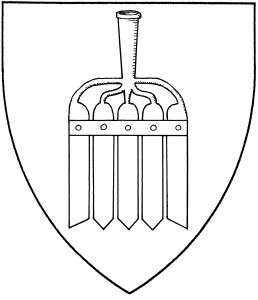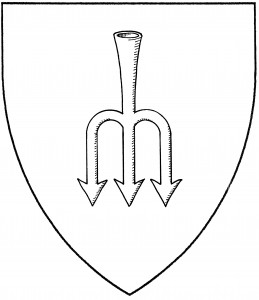An eel-fork, or eel-spear, is a tool used by fishermen in taking eels. It consists of a multi-tined head with broad, flat points; the shaft is not shown. Examples of the artifact can be found as early as the 16th Century; as a charge, the eel-fork is found in the arms of Stretele or Stratley, c.1413 [DBA2 350; cf. Parker 220]. The illustration is based on a period artifact.
Similar to the eel-fork is the “salmon-spear” or “harping iron”, often shown in armory with a fish transfixed on its tines, as seen in the arms of Ränntl, mid-16th C. [NW 151]. It differs from the eel-fork in that its tines are narrow and barbed, rather like a trident head. (Nonetheless, this form was also, confusingly, blazoned as an “eel-spear” [cf. Guillim1 220]; there seems to have been no consistent distinction between the various forms.)
The eel-fork and its variants have their points to base by default. For related charges, see fork.
Varukh syn Iarygin bears: Per bend sinister argent and vert, four eel-forks conjoined in cross by their bases counterchanged.
Dorothea af Holm bears: Gules, an eel-fork, on a chief argent an eel sable.

